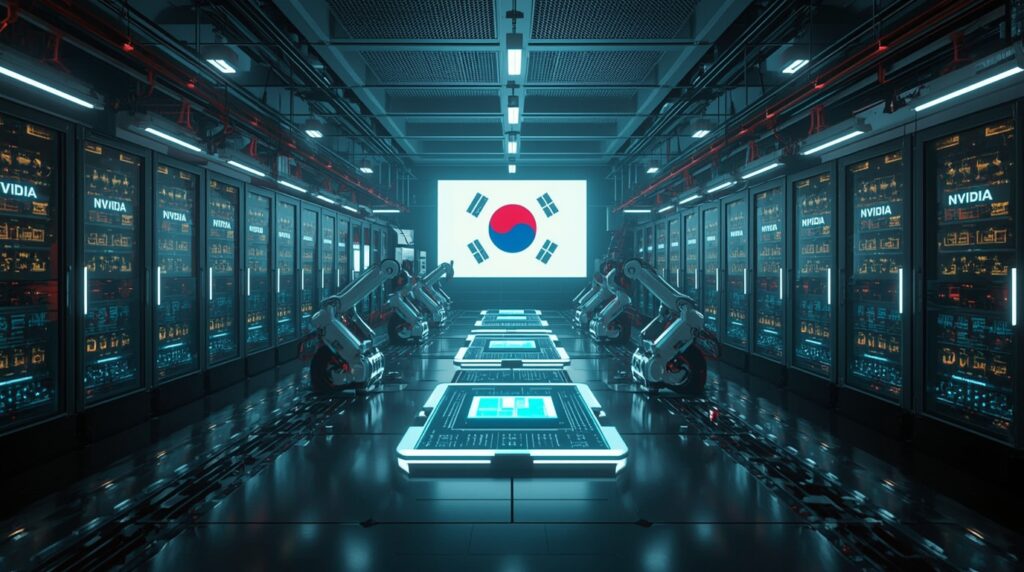
AI CERTS
2 months ago
AI Semiconductor Expansion: Nvidia’s Chip Strategy Supercharges South Korea’s AI Future

At a moment when countries are aggressively securing graphic processing units (GPUs) and accelerating chip sovereignty, South Korea’s strategic alignment with Nvidia signals more than technological ambition. It represents an economic necessity, industrial shift, and geopolitical strategy all converging at the silicon scale.
This AI semiconductor expansion narrative isn’t just about hardware—it’s about fueling tomorrow’s AI engines across robotics, digital government services, automated factories, biotech innovation, and national digital defense.
Why This Move Matters: The New Geopolitics of Compute
AI-driven transformation increasingly depends on access to elite semiconductor technologies. In this global surge, chips have become the new oil—fueling everything from autonomous production to scientific simulation.
Nvidia’s commitment to South Korea positions the nation to scale:
- High-performance data centers
- AI-driven biotechnology research
- Autonomous mobility initiatives
- AI-powered manufacturing lines
- National digital transformation programs
Every GPU deployed strengthens computational self-reliance and innovation leadership. With AI semiconductor expansion accelerating across Asia, South Korea is strategically asserting itself as a foundational player in the smart-nation era.
As AI systems become more capable and integrated into competitive economies, chip access becomes infrastructure, not luxury.
Data Center Expansion: The New Digital Power Plant
South Korea is actively modernizing its digital backbone, developing high-density data centers engineered for energy efficiency, sustainability, and machine-first workflows. The influx of Nvidia hardware will fuel:
- AI simulation environments
- Massive model training and inference clusters
- Enterprise-grade automation systems
- 5G-to-AI network integration
- Industrial robotics and smart factory ecosystems
This AI semiconductor expansion isn’t just supporting data processing—it’s shaping urban innovation, cybersecurity, and industrial optimization at scale.
Every new rack of advanced GPUs builds the foundation for future AI economies.
Industry Transformation: Manufacturing to Medicine
Nvidia’s strategic push aligns with South Korea’s long-term tech mission—automating industry, commercializing AI models, and embedding intelligence into physical and digital infrastructure.
Expected outcomes include:
- Faster chip-fabrication R&D cycles
- Automated factories with AI-driven quality control
- AI-first automotive innovation and smart mobility systems
- Healthcare platforms that accelerate diagnostics and treatment analytics
- Generative AI solutions for enterprise decision-making
The ripple effect will move through education, research institutions, national agencies, and private enterprises—strengthening the country’s innovation fabric.
This marks a decisive chapter for AI semiconductor expansion, one where industrial leaps are powered by computational strength, not traditional labor or capital alone.
Talent & Workforce: The Skill Shift Has Begun
Massive compute investments demand a highly skilled ecosystem—engineers trained in semiconductor systems, distributed training pipelines, AI model optimization, and infrastructure management.
To empower talent pipelines and future-ready innovators, individuals and enterprises are increasingly seeking globally recognized credentials. Programs like the AI Developer™ certification support professionals aiming to work directly with next-gen AI systems and intelligent compute environments.
AI leadership is shifting from experimentation to industrial-level deployment. South Korea is preparing not just infrastructure but people—cultivating a workforce aligned with the national AI strategy.
The Silicon-Powered Future: Enterprise and Economy
A surge in AI semiconductor expansion drives cross-sector gains, including:
- Energy-efficient smart buildings
- Digital twin infrastructure planning
- Secure AI-enhanced public services
- Scaled cloud-AI platforms
- AI-augmented R&D and materials science
The economic multiplier effect will accelerate national competitiveness. Vision meets hardware, and hardware meets innovation.
For professionals aiming to specialize in data-driven enterprise AI, the AI Data™ certification helps shape the capabilities required to build scalable intelligent systems powered by advanced GPUs and high-volume training data pipelines.
Investment Wave: Who Wins Next?
Global investment momentum in AI silicon continues, with governments and enterprises increasing sovereign compute budgets. South Korea’s move reinforces a pattern visible across the AI race: nations are securing compute at an industrial scale to compete in trade, science, and digital infrastructure strength.
Organizations adopting accelerated GPU ecosystems early stand to lead in:
- Enterprise automation
- AI-enabled logistics and supply chain planning
- Advanced defense research
- Cloud robotics integration
- Real-time industrial analytics
And for leaders navigating AI-integrated economies, the AI Finance™ certification becomes a valuable asset—aligning financial strategy with compute-powered innovation demand.
Conclusion: Chips, Strategy, and the Road Ahead
Nvidia’s 260,000-chip deployment marks more than capacity expansion—it reflects a nation positioning itself as a global AI powerhouse. South Korea’s strategic investment sets a precedent for the next generation of intelligent industry, enabling next-level AI experimentation, industrial automation, and data-driven governance.
As the AI semiconductor expansion reshapes global technological power structures, compute becomes currency and innovation becomes infrastructure. The future belongs to nations—and professionals—who build for scale, accelerate talent, and align strategy with the power of silicon-based intelligence.
Curious how AI is transforming industrial automation? Read our previous coverage on humanoid automation and discover how robotics and AI are reshaping global manufacturing.



